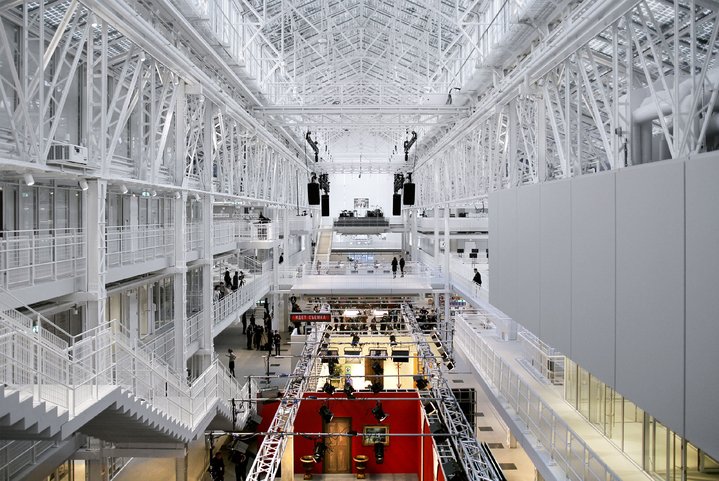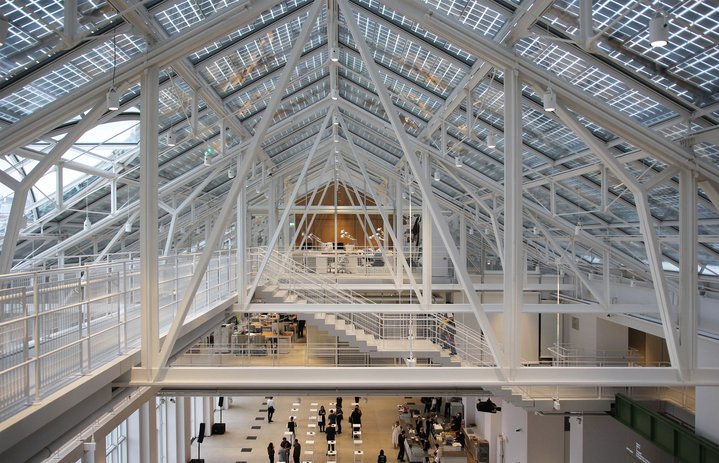GES-2: a new cultural hub to stimulate contemporary art in Russia

Designed by starchitect Renzo Piano, this House of Culture looks to the future by rethinking the past.
The opening of a recently renovated landmark in Moscow -- a former power station converted into an art centre - promises to enhance and energize the contemporary Russian scene. The artists and, above all, the visitors, needed something like this: a space with free admission, with a first-rate offer, culture served on an understandable and accessible plate. This openness is not solely conceptual and extends to the building itself. GES-2 has been purposed as more of a public square, a piazza, as Francesco Manacorda - artistic director of the Foundation behind this project, V-A-C - told journalists. It finds inspiration in the Houses of Culture - public spaces for workers - created during the late Soviet imperial period, as a precedent. Renzo Piano’s design is based on transparency: the façade is entirely pierced by vast glass doors and windows, and the interior space is roomy and bright. On the opening day, Piano spoke to journalists about his vision and his mission: the poetry of light is essential, he said. He also affirmed something that caught my attention: “To make a good building you need a good client.”
“For art to flourish, not only artists are needed, but also patrons,” said Konstantin Stanislavski over a century ago in the middle of the Russian ‘Silver Age’, years in which culture rose thanks to the philanthropy of the Morozovs, Shchukins, Riabushinskys, Bakhrushins, Tretyakovs or Mamontovs. Perhaps that past legacy which Leonid Mikhelson, founder of V-A-C Foundation and Novatek gas company head, and Teresa Iarocci Mavica, who was the director of the foundation until the end of December 2021, wanted to pay tribute to will lead the country towards another creative peak. Of course, the first steps are sound: the programming for the next three years relates to the title ‘Holy Barbarians, or Both Are Worse’ and will be divided into six-month sessions. The initial ‘Santa Barbara -- How Not to Be Colonized?’ is a funny affront to identity clichés. The first floor is dedicated to a film set that will recreate, with local actors and the improvised appearance of the public, ‘Santa Barbara’, which was the first American soap opera to be broadcasted on Russian television. The influence it had during the years it was aired (1992--2002) goes beyond the number of dogs that were named Mason, Eden, Cruz or C. C. Capwell, after the characters of the series. Artist Ragnar Kjartansson conceived this project as a living and emotional sculpture. Kjartansson together with Ingibjörg Sigurjónsdóttir are also curating ‘To Moscow! To Moscow! To Moscow!’, a witty selection of artworks.
The other big exhibition links the carnival with the beginning of the Russian contemporary art scene of the early 1990s and follows Mikhail Bakhtin’s theory of the carnivalesque. The public can find handmade costumes floating on hangers from the ceiling, a VR experience and a standup comedy platform, which has welcomed some humoristic readings. It was, without a doubt, a risky bet considering the increasing censorship policy against comedians and artists nowadays. Will GES-2 become a kind of a sanctuary for them? We already know of a bad precedent. The title of Ragnar Kjartansson’s performance ‘God, Moscow’, shown in his exhibition, has been translated into Russian as ‘Untitled’.
Two years ago, Kjartansson explained the change of name in an interview to The Art Newspaper Russia: “We discussed it with the V-A-C team and they said, ‘OK, we can keep the name ‘God’, but it will cost us a big scandal in Russia’ and I wasn’t interested in causing a scandal around the idea of God. When you say God in Icelandic culture or in some Western European country, there’s nothing special about that, but when you say ‘God’ in Russia, it’s a different thing. So, I just changed the title, because the point of the piece is not to argue about what God is. The point of the piece is to reflect on the idea of sadness.” The categorically sad thing in my view is that the foreign public read the original title and the locals must read an altered one. It seems that not even a project that is born from private patronage, without any public financial support, will be able to escape the governmental censoring mentality today. President Vladimir Putin, who visited GES-2 in a televised tour in the purest Santa Barbara-style two days before the opening, said, according to Teresa Iarocci Mavica: “How can you not support a wonderful place like this?” I know it is too soon to determine whether Kjartansson’s anecdote will only provide material for the standup platform (“How Russians are praying to Untitled”), or if it´ll become something more serious than that; for now, the only really questionable thing about the feasibility of this new art centre is the function of its solar panels.
Season 1. Santa Barbara – How Not to Be Colonized?
Moscow, Russia
December 4, 2021 – March 13, 2022









